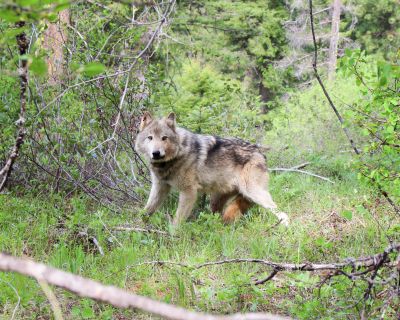Wolf-livestock conflict hit new high in Washington last year

Conflict between wolves and livestock hit a high in Washington in 2024.
Wolves injured or killed at least 56 cattle in the state in 2024, according to Washington Department of Fish and Wildlife records.
The total, which includes confirmed and probable depredations, is the highest the department has recorded since it started tracking wolf-livestock conflict, and it’s more than double the total cattle injured by wolves in 2023.
It comes as the state’s wolf population continues to grow and expand into new areas. WDFW’s minimum count last spring found the state had at least 260 wolves, a 20% increase over the year before.
Subhadeep Bhattacharjee, WDFW’s statewide wolf and grizzly bear policy lead, said the number of livestock injured or killed by wolves may change when the department publishes its annual wolf report in April. But he did say that it’s clear 2024 was a tough year for livestock producers and wolf managers.
“This year was very challenging,” said Shubh Bhattacharjee, WDFW’s statewide wolf and grizzly bear policy lead.
And it’s bleeding over into 2025. This week, WDFW director Kelly Susewind OK’d the killing of up to two wolves from the Columbia pack in southeast Washington after the pack was deemed responsible for the death of a calf in a corral on Dec. 29.
Bhattacharjee said it was the first time anyone involved recalled a lethal removal operation taking place in January.
“This is really a game changer this time,” he said.
Tensions over wolf management ran high all year long. In July, the Washington Fish and Wildlife Commission rejected a WDFW plan to reduce protections for wolves, a move that rankled ranchers and law enforcement officials seeking more management flexibility but drew cheers from environmentalists who say the wolves are far from recovered.
WDFW’s consideration of lethal removal for wolves involved in conflicts also proved controversial. Including the decision this week, the agency has OK’d the killing of wolves five times since July. Hard-line wolf advocates have railed against those decisions as the wrong way to resolve conflict while ranchers and others have criticized the agency for not taking action quickly enough.
Meanwhile, the U.S. Fish and Wildlife Service is investigating the illegal killing of three wolves in Okanogan and Klickitat counties, where the animals are protected under the federal Endangered Species Act.
WDFW’s official counts have shown a growing wolf population for 15 consecutive years, and the animals continue to find their way into new places. Biologists have just started working on the 2024 count, which will be published with the annual wolf report this spring.
Most wolves stay out of trouble. WDFW’s monthly wolf reports routinely point out that the vast majority of the state’s 42 packs have not been involved in any run-ins with livestock.
At least eight packs did have run-ins with livestock in 2024. Nearly all of them were in the state’s eastern third, where the wolves are not federally protected.
The Columbia pack had the second-highest depredation total of any pack. The wolves roam Columbia County in the southeast corner, and the dead calf reported in late December was the 12th animal found either dead or injured in the pack’s territory since this summer, according to WDFW.
The Dominion pack, which roams a territory northeast of Colville, took the highest toll. WDFW linked the pack to the deaths of five cattle and the injury of 13 others. The incidents were all confirmed in late July and early August.
Three other packs in the northeast corner were blamed for attacks on cattle this summer.
Jay Shepherd, wolf program lead for Conservation Northwest, said there have been other years with high levels of conflict in northeastern Washington, which is where the bulk of the state’s wolves live.
He added that a rancher doesn’t need to lose cows to feel the impact.
“I watched people this summer who were not having depredations, but they had wolves on their allotment, and their stress level is pretty high,” Shepherd said.
State law gives ranchers in the eastern third of the state some leeway in dealing with wolves, allowing them to kill a wolf when it’s caught in the act of attacking cattle. One wolf in the Couse pack in southeast Washington was killed in July after a producer caught it chasing cattle. The state investigated and found the act was justified.
WDFW is still investigating the killing of a wolf from the Leadpoint pack, which was linked to four attacks on cattle last year.
WDFW staff killed four wolves in 2024 in response to livestock conflicts. The agency can consider removing wolves after repeated depredations provided they meet the threshholds set forth in the state’s wolf-livestock protocol – either three attacks in 30 days or four in a rolling 10-month period.
The guidelines also stipulate that ranchers have to use nonlethal measures to deter conflict, such as range riding.
The agency has killed more wolves in years past, and it did formally reject the lethal option four times in 2024.
But some environmentalists say WDFW is approving wolf kills far too often, and that the killings don’t have their intended effect.
After the agency approved killing up to two members of the Columbia pack this week, Wildlife For All Executive Director Michelle Lute issued a statement blasting the decision.
“Since last year, WDFW has displayed an uncharacteristically aggressive stance toward wolves, authorizing lethal actions at an alarming rate,” Lute said. “This approach ignores a growing body of research that shows killing wolves often exacerbates livestock conflicts rather than reducing them.”